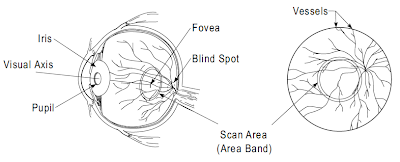I have already introduced you to retinal scanning in my previous post The King of Biometrics. However retinal scanning has a younger more lighthearted brother: the iris scan.
To most people scanning of the eye is all the same and people constantly mix up the terms iris and retina scans (even the U.S. Army did it see Biometric Army), my hope is that after reading this post you will never make the same mistake.
So let’s start by defining what an iris is as compared to the retina. I found a picture that is a good representation of this. If you look at someone’s eye, the colored section you see is the iris. That is what is scanned using an iris scanner. Behind someone’s eye is the retina, and this cannot be seen with the naked eye. That is why retinal scanners use IR rays in order to generate an image of the retina.
Now you know the major difference between the two technologies. However I am not going to stop there. I will tell you how you can easily distinguish between the two technologies if you saw someone using them.
A retinal scanner is considered more intrusive and is also slower. For a retinal scan the subject’s eye generally has to be within 3 inches of the scanner and the subject has to focus on a point of green light that he/she would see in the scanner. The retinal scanner scans about 400 reference points that it uses for identification processes and it takes about twenty seconds.
As compared to the retinal scanner an iris scanner is a lot faster taking only about two seconds. The iris scanner can be used from a much farther distance of up to two feet and uses about 240 reference point.
So basically if the scan is taken at a very short distance and if the scan takes a little while then it is a retinal scan, and if it is done at a longer distance and is instantaneous then it is an iris scan. Now hopefully you will never make the mistake of misidentifying the two technologies.
Iris scan sounds better doesn’t it? It is faster and cheaper but also less accurate. As I described in King of Biometrics retinal scanners are basically foolproof, which leads to an interesting post that is coming up (stay tuned).






